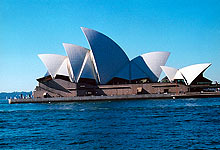 |
|
We completely lost Friday on our trip to Sydney in 2000. Mary Jane and I took off from Los Angeles at ten o’clock Thursday night and, after crossing the International Date Line, arrived at the Sydney airport at 6 a.m. Saturday morning. Since we had been flying for nearly fifteen hours, I didn’t mourn the loss of Friday–I just wanted off the plane. Fortunately, Robynne Millward and her friend Wayne were waiting to pick us up, so within forty-five minutes we had checked into our apartment at the Radisson Kestrel Hotel on the beach in Manly (north of Sydney) and were having our second jet-lagged breakfast of the morning at a beach-front café. The weather? Think summer in San Francisco.
“So how goes the show?” I asked Robynne, the editor and publisher of The Chilli Press and producer of the third annual Australian National Fiery Food Festival. It was the final event in the three-week-long Feast of Sydney promotion.
Robynne shrugged. “Things could be better in Oz.” (“Oz” being the Aussie nickname for their country.)
Uh-oh, I thought, the show production instincts in my body on alert. “What’s wrong?”
It turned out that the problems had to do with the venue itself. The show was being held in the ground floor lobby at the old Customs House. It is located at the Circular Quay (pronounced “key”–don’t ask why), which is the main wharf for the commuter ferries and a major train station as well. In a city of nearly four million people, it was about as central a location as one could find. But it wasn’t designed for shows. And the city government, which owned the building, was not cooperating.
“They won’t let me do cooking demonstrations in the building,” Robynne said, “and I’ve got the biggest star of Mexican cooking performing–Diana Kennedy.”
“Why not?”
“Against their policy–that’s all they’ll say.”
“What are you going to do?”
“Erect a tent outside on the plaza for the cooking demos–that’s all I can do.”
“But what about crowd control?” I asked. “They’ll have to present ticket stubs to get into the tent.”
“Not to worry,” Robynne replied. “We’re not allowed to sell tickets.”
“What?”
Robynne explained that since it was a public building, with three restaurants and numerous galleries, she was not allowed to charge admission to the show in the lobby. She could, however, asked for a “gold coin donation” (a $1 or $2 gold coin, worth about US 60 cents or $1.20, respectively) and charge admission to the cooking tent and to my slide show lectures.
“At least they’re not charging me rent,” she said. “And I’m not spending much on advertising because you’re here to get me all this free publicity, starting this afternoon.”
The Media Blitz
Lagged or not, I was scheduled for a book signing and lecture at Collins Booksellers, the equivalent of a Barnes & Noble super store in the States. Robynne showed me an article promoting the signing from the Sydney events magazine, Where. The blurb described me as a “famous American chef” and an “acclaimed author” in same sentence.
“But I’m not a chef at all, much less a famous one,” I protested.
“Don’t tell anyone,” Robynne ordered.
The book signing went surprisingly well. About 25 people showed up, and while Robynne made three or four salsas, I gave my talk on chiles and fiery foods and soon learned from the responses that there was a strong chilehead contingent in Australia–and that my books were as popular among those as they are among their American counterparts. Not only did these fans buy books at Collins, they also brought their dog-eared copies The Pepper Garden for me to sign. I had a great time and by four-thirty it was time to go. As we left the mall, they sky had darkened significantly. There were no clouds. I checked my watch again. What was going on? Then I realized that we had traveled from the longest day of the year to the shortest.
The week of the show was a blur of activities–press conferences, radio and television appearances, and newspaper interviews as I worked hard to earn my keep and promote the festival. In between these events, we managed to do touristy things like buy superb Aboriginal art in shops at The Rocks, stroll through the enormous–and beautiful–Botanical Gardens, visit the Taronga Zoo, tour the famous Sydney Opera House, and shudder when totally surrounded by those Great Barrier Reef predators in the shark tunnel at the aquarium.
Apparently the festival publicity was working, because there were more media messages every evening at the Radisson Kestrel, after we returned by ferry from the Circular Quay. The buzz was building.
The Australian Scovies
The heat was building as well, for I was one of the judges of the Australian Fiery Food Challenge, held at the Customs House before the show. It was a blind tasting with the labels of the products obscured as with our Scovie Awards in the U.S. The judges were mostly media people who covered food. More than 100 products were entered, and they were generally of good quality, with a notable sweetness as compared to the U.S. products–apparently the Aussies have quite as sweet tooth. There were two excellent salsas and a number of tasty chutneys. I made a noble attempt to taste every one of the products, but I made a crucial error: I tasted the habanero hot sauces before the group of “regular” hot sauces. I was so burned out that not only could I not finish the tasting, I felt dizzy and flushed–definitely a victim of an endorphin rush.
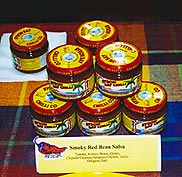 |
The grand prize winner was the Byron Bay Chilli Company, and they won, among other prizes, a booth in the 13th annual National Fiery Foods Show in Albuquerque, March 2-4, 2001, and they promised me they’d be there. |
 |
A Spicy Diversion
At the tasting, we were delighted to meet Carol Selva Rajah, a noted Australian food writer and cookbook author. She promptly adopted us and gave us a copy of her latest book, Makan-lah!: The True Taste of Malaysia. One of her projects during the Taste of Sydney was to produce the Batavia Rijistafel Banquet, a fourteen-course spice dinner held at the National Maritime Museum. Because of our intense interest in spices of all kinds, she really wanted us to attend this exclusive dinner. The main problem was that the museum had sold all the tickets in a matter of hours and there were no seats left. So Carol gave me her seat at the banquet! Unfortunately, there was no room for Mary Jane, so she was on her own back in Manly while I hobnobbed with the museum elite.
 |
Cocktails and starters were served aboard the Batavia, a full-size reproduction of the original Dutch spice ship that wrecked off the coast of Western Australia in 1629. It was moored at the museum, and I was fascinated to go aboard the remarkable replica. The ship was built by the Dutch government (it took ten years) and was transported to Sydney for the Olympic celebrations aboard a floating dock ship, and then was released to cruise into Sydney harbor under sail, accompanied by fireworks and the booming of its own cannons. Sipping on a Heineken (what else?), I went down the ladders to the spice storage deck and was amazed how cramped it was, with ceilings only about five feet off the deck. Here, the sacks of spices were stored–black pepper, long pepper, nutmeg, mace, cloves, and cinnamon. The sailors–all 300 of them–slept among the spice sacks because of the lack of room on the 193-foot-long ship. |
Carol did a superb job with the banquet and my seating. On my left was Christine Salins, the food editor of the Canberra Times, and on my right was a retired radio comedy writer. The wines, from Rosemount Estate, were great and readily consumed as course after spicy food arrived. The feast was a bit overwhelming, and I had to pace myself when trying something particularly tasty and spicy, like the Rendang Bambu Sapi, her beef and chile dish loaded with spices, and the Sambal Goreng Udang Karing, a delicious prawn sambal. In between courses, I discussed the spicy food movement in Australia with Christine, and the comedy writer explained the finer points of rugby and Australian Rules Football. I hadn’t been in Australia a week yet, but I felt right at home. It didn’t hurt that, in addition to socializing, I was reading Australian newspapers and magazines and watching TV.
Later, Carol took us to Cabramatta, a town outside Sydney where many of the Asian immigrants live. It was rather like being in Singapore, with Vietnamese soup shops, Cambodian discos, Chinese grocery stores, and Thai herb shops. We all ate the Vietnamese Beef Soup with chilli-garlic sauce, and it was unforgettably good. Carol also took us to one of the largest distributors of Indian food, herbs and spices in Australia and also referred us to Herbies Spices in nearby Rozelle. Herbie–or rather Ian Hemphill, recognized me because he sells dried chiles in addition to literally hundreds of varieties of spices. It was there that I bought the wild spicy mountain pepper that is gaining in popularity in Australian gourmet circles. And I was about to discover that it’s also used in some Australian commercial sauces.
Show Time
The immigration of Asians has helped spread fiery foods across the country. One of the biggest influences on fiery food in Australia has been the introduction and spread of habaneros. They are now second in popularity to the Asian varieties. Geoff likes to tell the story that he got into the fiery foods business because he couldn’t find a good Thai garlic-chilli-ginger sauce, so he had to make his own.
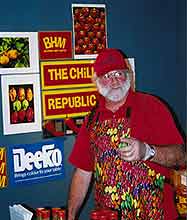 |
It’s always fun greeting the exhibitors at a show, and this one was particularly interesting because I’d never actually met any of these chile lovers, although I had exchanged email with some of them. Geoff Love, of Love’s Pantry, manufactures a line of forty different products, of which 28 are chilli-oriented. The spicy products are his BHM brand, which stands for “Bloody Hot, Mate!” Formerly in advertising and marketing, jovial Geoff told me that his products are selling well because they are distributed to both supermarkets and specialty food shops. Business is good, he said, because Australians are becoming more aware of chillis and the food that goes best with them. |
The husband and wife team of Joi and Mike Feiertag of Smoke Label Products are devoted to hot and spicy pickles, and they manufacture six different kinds, including chilli-stuffed olives. They were first time exhibitors but had four years experience in making the products at home. Their distribution is limited to a take-out restaurant, but they hope to increase production by using a co-packer.
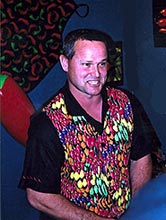 |
“The Chilli Man,” Brett Elphinstone, has had better luck with distribution, and his line of 20 products, including Wild Wombat Smoked Chilli Sauce, are carried both in supermarkets and specialty stores. He’s only been in business three years and says that fiery foods beats the hell out of his last endeavor as an unemployed miner. Brett told me that his skills as an amateur cook pulled him through during the hard times. |
John Boland, the owner of Byron Bay Chilli Company and the winner of the grand prize in the Australian Fiery Food Challenge, is a transplanted American who emigrated from Southern California in the 1980s and started making salsa in 1993. He was previously a caterer, so it was easy to transfer his experience to the manufacturing sector. He has about a dozen products, including a Black Bean Salsa, which is one of the ones I preferred at the tasting. John told me that the fiery foods industry in Australia is expanding rapidly, and that during the last three or four years his business has grown dramatically. And Australians want their food hotter and hotter, which agrees with what Geoff Love said about habaneros. Byron Bay Chilli Company has excellent distribution through Coles and Woolworth’s, the two major supermarket chains in Australia, and perhaps that’s why John’s sales have gone from 3,000 jars sold in 1993 to more than 180,000 jars projected for 2000. Another reason could be the excellent graphics on his labels, which were designed by John and his wife, Lynne.
A Real Chilli Wine
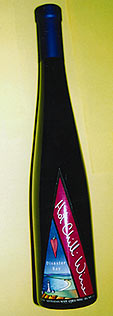 |
One of the most interesting and unusual chilli products we found was a chilli wine from the ominously-named but fully-flavorful Disaster Bay Chilli Company. Every chile wine I’ve tasted in the U.S. simply had some chile–green, red, or jalapeno–added to grape wine. But Stuart Meagher and his partner John Wentworth have developed a technique for making wine from fermented chillis. They got the initial recipe from an Aboriginal tribesman named Old Didler and experimented with it by using jalapenos, Big Jim New Mexican chiles, fresh cayennes, and a few habaneros thrown in. They used a French yeast and added a little sugar, since chillis don’t have the high sugar content of grapes. The resulting chilli wine tastes like a good dessert wine, with a noticeable bite, and I thought it was rather good. So did the public who tasted it during a talk on chilli beverages.
I asked Stuart about how he got into the chilli wine business and he said that their real job as cardboard recyclers was not the most interesting work in the world, and that they were chilliheads who took a wine making course and then things got out of hand. |
They make the wine in a temperature-controlled cellar, and it takes about 660 pounds of chillis to make 2000 liters of wine, which is aged for one year in barrels. The wine was entered in a wine festival in the town of Bega, where it was judged according to Australian wine making criteria, and it won a Bronze Medial. They use the chilli byproducts of wine making to create their other products, which are hot sauces and chutneys. Disaster Bay was the winner of the packaging and labeling awards.
Bush Food
Juleigh Robins is another Aussie with a unique approach to using chillis. Her specialty is bush foods–those native Australian plants that were mostly harvested in the wild until recently. With her ex-husband Ian, she founded Robins Australian Foods with three main product lines: Wild Lime, a high-end line featuring the tiny fruit of the wild lime, a true citrus; Robins Bush Foods, which feature other indigenous plants such as mountain pepper and the bush tomato; and Hot Oz, a line which combines native plants such as lemon myrtle with hot chillis.
 |
Juleigh Robins (Robins Australian Foods) |
Years ago, Juleigh and Ian were restaurant owners and then opened a specialty food store and became caterers. They started manufacturing their own condiments and that’s when Juleigh became interested in bush foods. She decided to learn all she could about them and see if she could incorporate them into her products. At first there was public resistance to their use, but she said that during the last ten years there has been a change of attitude regarding Aboriginals and their foods. In 1996, her first book on bush foods, Wild Lime: Cooking from the Bushfood Garden, was published and that gave her and her food products enormous credibility. It was the first book to cast bush foods in a gourmet light, and now Juleigh believes they are being accepted as legitimate foods that can reach an even greater popularity. Australians have always lacked a food tradition, but now authentic bush foods can give a burgeoning native cuisine some authenticity.
Her biggest problem has been finding a good supply of the bush foods. When she started fourteen years ago, all bush foods were harvested in the wild and the supply was severely limited. But now, because of organic permaculture farming systems, you can buy some bush foods–such as the bush tomato–by the ton. Now, with her supply system in place, Juleigh can concentrate on distributing her 22 retail products to gourmet shops, food halls, and some supermarkets. She has also made progress in exporting her products, and they are currently in 82 Karstadt stores in Germany and many of the Saintsbury stores in the U.K. Food service has also been successful for her and she supplies airlines, hotel groups and railway companies.
Party Party
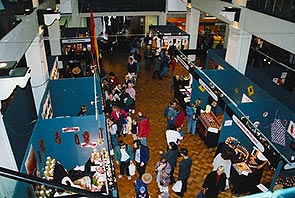 |
The third annual Australian National Fiery Food Festival was a rousing success and the crowds were so large on Sunday that it was difficult to move around in the hall.
|
The third annual Australian National Fiery Food Festival was a rousing success and the crowds were so large on Sunday that it was difficult to move around in the hall. The exhibitors were happy with the attendance, and as often happens during a show, the initial problems faded away. The cooking demonstrations went well, with many of the national magazines sending their food writers to watch Diana Kennedy and Carol Selvah Rajah cook on stage. Attendance at my slide shows increased steadily throughout the show, and I was happy to discuss chillis with the attendees, sign books, and help them identify the pods they brought with them.
The celebrations continued long after the show closed. One of larger parties, hosted by Robynne for the fifth anniversary of The Chilli Press, took place at Café Pacifico. I was apprehensive about eating Mexican food in Sydney, which is way south of the border, but not to worry. The general manager, Phil Bayly, who hosted the seminar with me on chilli beverages, put on a great feast for us and I learned that all his food is cooked from scratch using authentic ingredients. Honestly, the food was better than it is at most of the Mexican restaurants in Albuquerque. Phil had some of the best chilli-infused tequilas I have ever tasted. And the margaritas were marvelous.
Another wonderful restaurant was the Rattlesnake Grill, a place Victor Pisapia and his partner Jim have dubbed “Santa Fe at Neutral Bay,” with Neutral Bay being the community where it is located. Although the restaurant serves Barbecued Duck Blue Corn Crepes, Puebla Chicken, and other Southwestern-style dishes, Kangaroo Loin is also on the menu at the Rattlesnake Grill. Incidentally, for those of you who wonder, kangaroo loin tastes very much like lean roast beef. (And no, they don’t serve koala or platypus meat anywhere in Australia, but I did spot emu and crocodile on some restaurant menus.) Victor, who is the main chef at the Rattlesnake, serves the ‘roo seared medium rare with a spicy grape sauce and dijon-mashed parsnips. He also manufactures a line of Rattlesnake Grill products that were some of my favorites at the show.
Our final evening in Australia was spent with Robynne and Wayne at Red Gum, a restaurant in Manly that served what might be called gourmet bush food. We did a post-show analysis and all were convinced that fiery foods are not only here to stay in Oz, but probably will become a major food movement. Robynne asked if we would be interested in returning for the show the following year and we enthusiastically said yes. After all, we didn’t even get to go crocodile hunting!
On the flight back, we landed before we left, and recovered the Friday we lost on the way to Oz. That’s right, we took off from Sydney airport at 9:30 a.m. on Thursday and landed at LAX at 6:30 a.m. the same day. Now that’s a fast plane!
Believe Oz or Not
Apparently Australia is a land of mystery for the rest of the planet. How else are we to explain the questions that were asked of SOCOG (Sydney Organising Committee Olympic Games) through its website? “Can you give me information about hippo racing in Australia?” was one of the more imaginative queries, as was “Do you have perfume in Australia?” We could almost expect “Will I be able to see kangaroos on the street?” and “Is it safe to run around in the bushes?”, but what possessed potential visitors to inquire: “Is milk available year-round?” A fashion-obsessed woman asked “Can I wear high heels in Australia?”, but my favorite question was “Which direction is north in Australia?” The answer is that north is the direction of the hippo races.
I also noticed that the Australian press was determined to counter many of the legends associated with their country. For example, Australians are known worldwide for their supposed ability to consume large amounts of alcoholic beverages, particularly beer. A magazine article disputed this assertion by pointing out that despite consuming 385 million gallons of beer per year (more than 20 gallons for every man, woman, and child), Australia ranked a poor seventh in per-capita beer consumption, behind the Czech Republic, Germany, Ireland, Austria, Britain, and Belgium. I did my share in boosting Australian consumption, and I particularly enjoyed Toohey’s Old, a fine dark ale.





